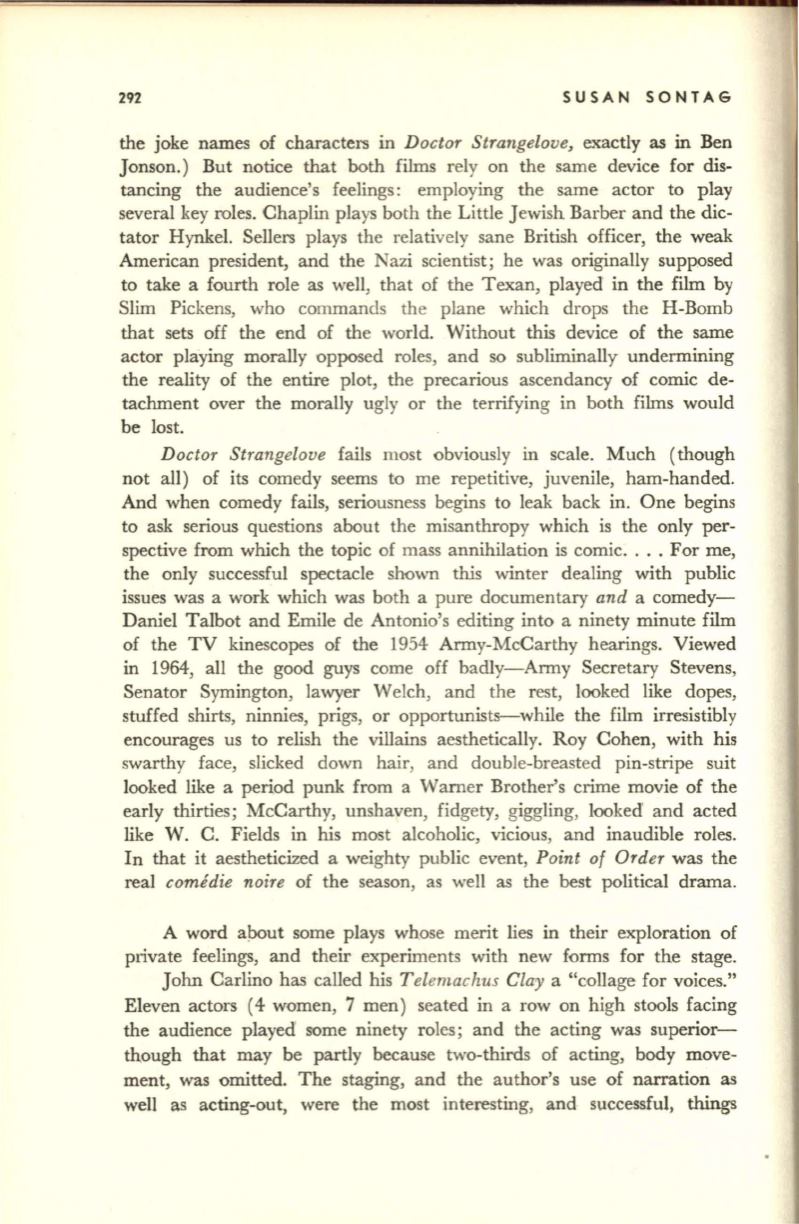
292
SUSAN SONTAG
the joke names of characters in
Doctor Strangelove,
exactly as in Ben
Jonson.) But notice that both films rely on the same device for dis–
tancing the audience's feelings: employing the same actor to play
several key roles. Chaplin plays both the Little Jewish Barber and the dic–
tator Hynkel. Sellers plays the relatively sane British officer, the weak
American president, and the Nazi scientist; he was originally supposed
to take a fourth role as well, that of the Texan, played in the film by
Slim Pickens, who commands the plane which drops the H-Bomb
that sets off the end of the world. Without this device of the same
actor playing morally opposed roles, and so subliminally undermining
the reality of the entire plot, the precarious ascendancy of comic de–
tachment over the morally ugly or the terrifying in both films would
be lost.
Doctor Strangelove
fails most obviously in scale. Much (though
not all) of its comedy seems to me repetitive, juvenile, ham-handed.
And when comedy fails, seriousness begins to leak back in. One begins
to ask serious questions about the misanthropy which is the only per–
spective from which the topic of mass annihilation is comic.... For me,
the only successful spectacle shown this winter dealing with public
issues was a work which was both a pure documentary
and
a comedy–
Daniel Talbot and Emile de Antonio's editing into a ninety minute film
of the TV kinescopes of the 1954 Army-McCarthy hearings. Viewed
in 1964, all the good guys come off badly-Army Secretary Stevens,
Senator Symington, lawyer Welch, and the rest, looked like dopes,
stuffed shirts, ninnies, prigs, or opportunists-while the film irresistibly
encourages us to relish the villains aesthetically. Roy Cohen, with his
swarthy face, slicked down hair, and double-breasted pin-stripe suit
looked like a period punk from a Warner Brother's crime movie of the
early thirties; McCarthy, unshaven, fidgety, giggling, looked and acted
like W. C. Fields in his most alcoholic, vicious, and inaudible roles.
In that it aestheticized a weighty public event,
Point of Order
was the
real
comMie noire
of the season, as well as the best political drama.
A word aPout some plays whose merit lies in their exploration of
private feelings, and their experiments with new forms for the stage.
John Carlino has called his
Telemachus Clay
a "collage for voices."
Eleven actors (4 women, 7 men) seated in a rowan high stools facing
the audience played some ninety roles; and the acting was superior–
though that may be partly because two-thirds of acting, body move–
ment, was omitted. The staging, and the author's use of narration as
well as acting-out, were the most interesting, and successful, things


